People With Funny Things Rigting in T Shirts
You've got the office. You've got the website. You even have the legal docs. But everybody knows that you're not a real company until you have your own company t-shirt.
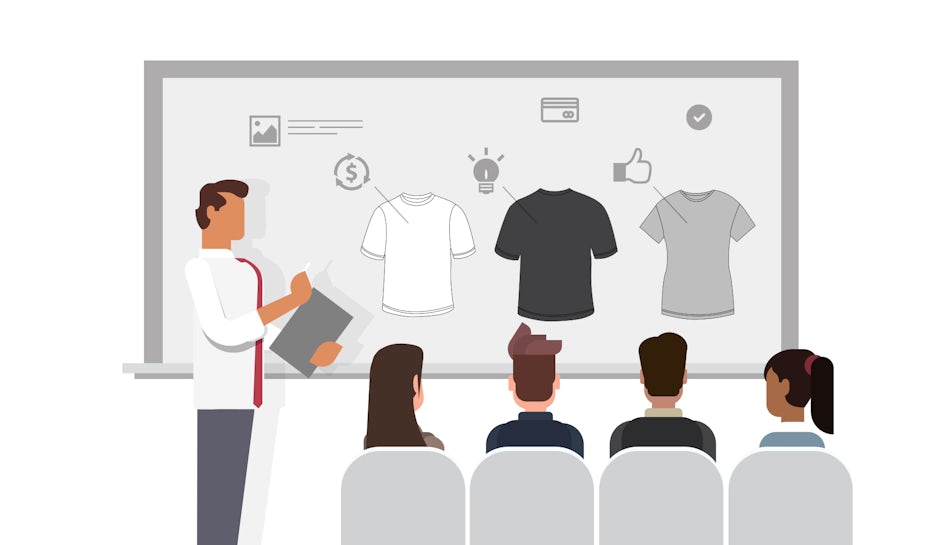
Company tees are a long-standing tradition traced back to 1950s Miami where local resorts first experimented with advertising logos on t-shirts, including Walt Disney's iconic Mickey Mouse. Today, the business t-shirt is still just as practical, offering lots of benefits to companies big or small.
In this Ultimate Guide to Business T-Shirt Design, we'll go through each step of the process, from brainstorming ideas to printing your shirt. No matter how much (or how little) experience you have, here's everything you need to know.
We've just sent you your free t-shirt design ebook.
How to design a business t-shirt in 8 steps
—
Table of Contents
- Figure out why you need a shirt
- Define your budget at quantity
- Know your printing options
- Screen printing
- Vinyl graphics
- Direct-to-garment
- Brainstorm your design concept
- Business t-shirt types
- Style and imagery
- Typography
- Color
- Specialty printing
- Find a designer
- Evaluate your design
- Get the right files
- Find a kick-ass printer
1. Figure out why you need a shirt
There's no shortage of reasons to want a company tee. These business t-shirt goals will guide your design process by helping you understand why you need a shirt and what you want it to do.
Promotion
Promotional business t-shirts are something you give away for free to keep your brand in the minds of prospective clients and customers.
This makes everyone wearing your t-shirt a walking advertisement. On enough people, your t-shirts could generate buzz and create first impression of your brand, especially when coupled with a powerful image.
Meeting leave-behinds
For meetings with potential clients, investors or partners, a company t-shirt is the perfect souvenir to remind them later how great you are.
Brand values
A picture is worth a thousand words, which makes business t-shirts the perfect elevator pitch. Through strategic visuals and only a handful of text, a solid t-shirt design tells the world what your brand has to offer.

For example, let's look at the Farmerceuticals shirt. The scenic nature imagery and green color schemes are obvious choices, but on a deeper level the prominent fist and art style give it more powerful and tough vibes. A good t-shirt design influences people's impressions of the brand.
Internal solidarity
Like uniforms except more fun, company t-shirts help build a sense of community among workers within a company… and that goes double if they give input on what it looks like.
Merchandise
If your designs are appealing enough, you can sell your t-shirts as merchandise for a little extra company income.
Promotion and extra cash? That's a win-win.
Events
Whether you're organizing a public promotional event or an internal retreat, event t-shirts generate team spirit and act as a nice memento to keep you fresh in prospective partners' minds.
Finally, write out a list of the key themes, styles and personality traits that you want your brand and business t-shirts to convey. Is your brand playful or serious? Edgy or conservative? Luxurious or affordable? A t-shirt design will answer all of these questions at a glance.
To get the most effective design, move away from your personal preference and rely on real, quantifiable data. Who are your target clients/customers? What brand traits do they want to do business with?
Once you've determined your goals, you can then prioritize the different aspects of your t-shirt design. You want to tailor your design in a way that best suits your needs.
2. Define your budget, quantity and timeline
As with most projects, start your business t-shirt design process by figuring out a few specific details.
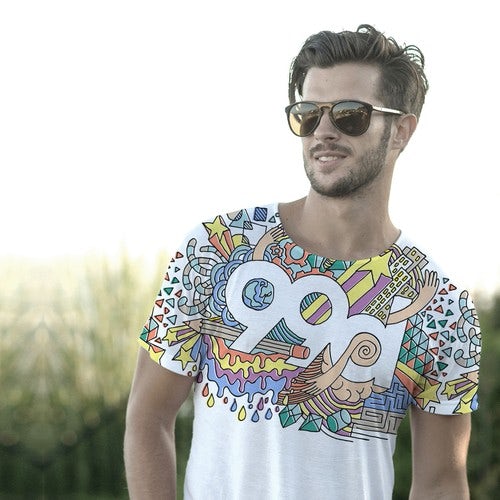
Quantity: How many do you need?
The amount of shirts you need directly affects the best printing method to choose. Some methods cater specifically to large bulk orders, while others have a high per-unit cost, limiting them to smaller numbers unless you have a big budget.
Budget: How much can you spend?
A bigger budget means more than just more shirts. If you want to print more detailed images with more colors, that will cost more. Want softer shirts or maybe a V-neck? Increase that budget. Think about dollars early so you can f ind your perfect balance between all of your creative options and the number of t-shirts you need.
Timeframe:When do you need the shirts?
Designing takes time. Printing does too, and different methods have different production turnaround times. Set flexible deadlines that give you time to develop a design and collaborate with your printer.
Get these specifics down, you'll have everything you need to determine the right t-shirt printing method.
3. Know your printing options
Sifting through printing methods is where a lot of would-be t-shirt designers get lost. There are several different ways to go about it, and the technical issues can be intimidating unless you know what they mean. Here are the four most effective t-shirt printing methods and the best times to use each.
Screen printing
The most affordable option for large orders, screen printing is the standard route for t-shirt printing. In this process, an individual screen is created for each color in your design, then printed one atop the other.

Pros : Reliable standard for printing. Affordable and high quality. Ideal for large orders over 20.
Cons: New screen required for every new color or design revision (which gets costly). Colorful designs end up being expensive.
Vinyl graphics
Vinyl graphics are a form of heated transfer. Vinyl is durable, helping your shirts last longer and safeguarding against fading images, and it also add mores texture to your t-shirts.
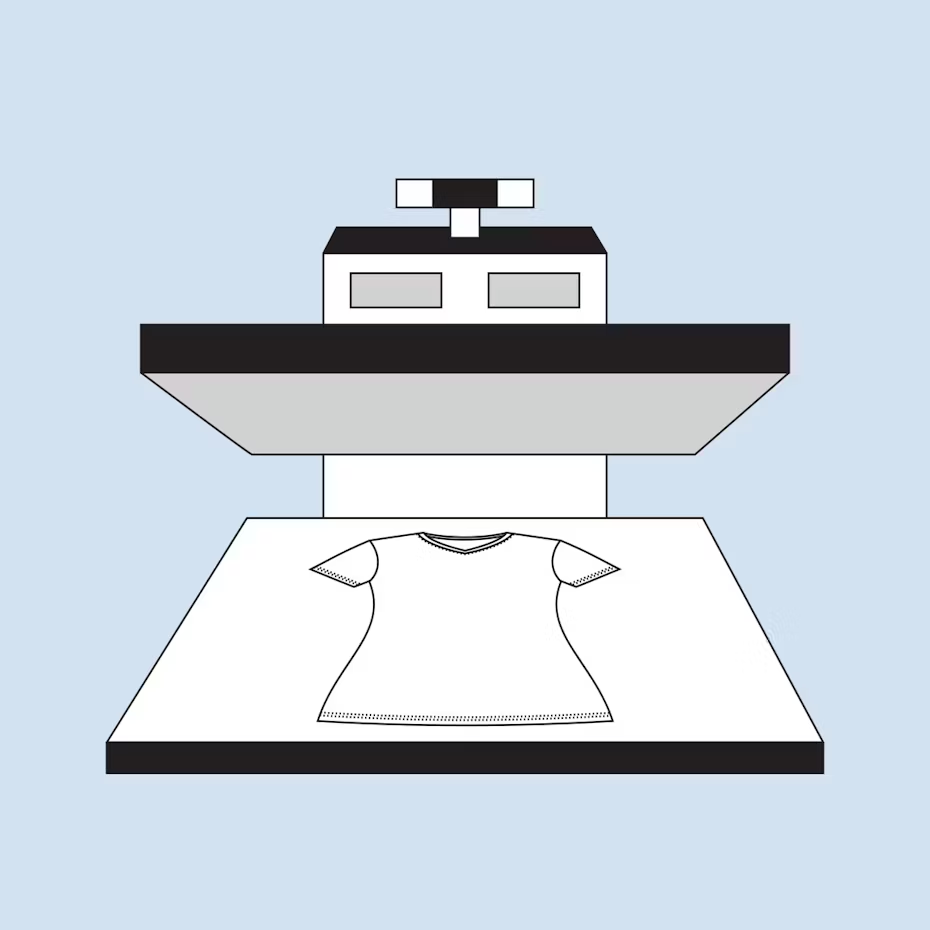
Pros: Extremely durable and high quality. Ideal for when you want your design to stand out (literally).
Cons: Additional colors cost more, so complicated designs get expensive. Not great for large orders.
Direct-to-garment (or print-on-demand)
One of the newest options for t-shirt printing, DTG printing makes use of inkjets, except they're applied directly to the fabric rather than an intermediary paper transfer. Of all the options in this list, DTG printing offers the most details and color options, allowing you to showcase Mona Lisa -level quality on your cotton canvas.

Pros : Highly customizable designs with maximum detail and extensive color choices.
Cons : Use for small batches or perhaps a single sample. The more you're printing, the less viable it becomes. Doesn't work well on dark-colored garments.
4. Brainstorm your design concept
Business t-shirt design isn't just about knowing what ideas to communicate, but how to communicate them effectively. Start brainstorming your ideas and channeling your creativity with these tips.
Don't start here, though. The more time and effort you put into preparing for this, the better.
T-shirt types
If you haven't already, you need to decide what style of t-shirt to use: crew neck, V-neck, long-sleeved, short-sleeved, crop tops, polo, and many others…
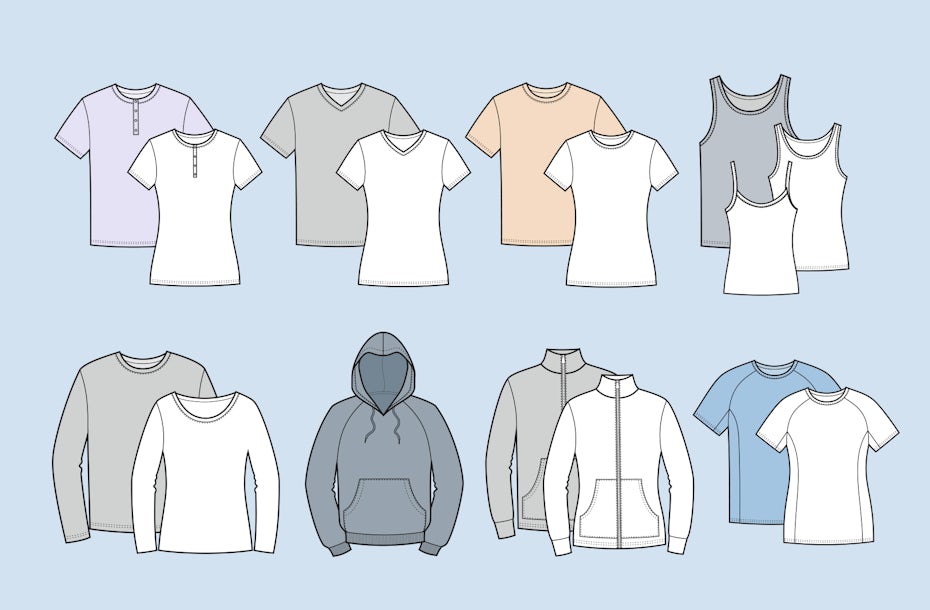
Aside from financial considerations, the type of t-shirt you choose also brings some unique design choices.
For example, a long-sleeved t-shirt offers the opportunity to print your brand name or slogan down the length of the sleeves. A pocket can be easily implemented in a design, such as having your mascot appear inside. More fashionable options like crop tops or off-the-shoulder tops appeal to more stylish crowds, but could alienate the mainstream.
Choose a style that complements your message, and then take advantage of what that style has to offer.

The basic canvas
As you start sketching out ideas, make sure it will translate to the actual size. Design using an 18"x18" canvas and physically place your designs on a shirt. That doesn't mean you have to fill the whole space (like if you're keeping it minimal with a small logo), but a realistically sized canvas will help you get the proportions right.
T-shirt sizes
Do you know the different proportions for a child's size 4 compared to XXXL? Images scale differently, so extreme sizes may distort your images. Plan ahead by testing different sizes to make sure you don't spoil any details.
Also, keep in mind that screen printing may require additional screens for different sizes. To keep costs down, you may need to sacrifice quality for the extreme sizes or not print them at all.
Style and imagery
Start thinking about how you can images and color to communicate the messages you want to say. Keep these questions in mind:
- What is your brand?
- Who is your market?
- Why are you designing a shirt in the first place?
Need ideas? Check out our gallery of t-shirt inspiration. Put all of that together, and you're ready to start creating your business t-shirt.
Despite being artistic, t-shirt design is still a business endeavor. There are plenty of logistical and financial concerns that restrict your creative freedom, including the level of detail. Complex imagery doesn't translate well to fabric, even though it may be better a better visual design.
Plus, your design is displayed on human bodies, full of unpredictable curves and constant motion. These conditions favor a flat perspective and simple details, not to mention that passersby only see the design during a momentary glance.
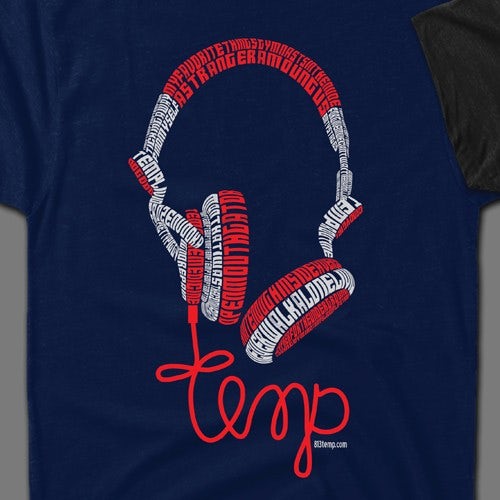
T-shirt typography
Like colors, your fonts, styles, and text sizes all influence how your brand is perceived. Serif fonts (the letters that have little tags on the ends) give your brand a more formal or traditional look. Sans-serif fonts (no tags) look more modern.
One important note for t-shirt typography is to keep readability in mind. Using an elaborate font may make the shirt more visually stunning, but if words become illegible, what you gain isn't worth what you lost. Just remember that if you want passersby to read the words on your shirts in just a moment or two, prioritize legibility first, appearance second.
Color in t-shirt design
Color is the best element of design for communicating personality. The individual shades, hues, and tints of each color alters the emotional connotation ever so slightly, giving designers a breadth of options for sending the right messages. But it's not just about picking the right colors that match your brand, but also picking the colors that go well together.

In addition to choosing the colors for the shirt image, you also need to pay attention to how those colors look with the color of the shirt itself.Because of the way t-shirt inks work, printing colors can get a little tricky. The least expensive way to print your design will be to approximate the colors. But remember your "aquamarine" might be different from your printer's "aquamarine."
While PMS and CMYK inks may be more expensive, they are more reliable. PMS uses premixed inks that your printers can buy. CMYK printing creates colors by mixing Cyan, Magenta, Yellow and Key (black) inks. Check with your printer to determine what's available.
Specialty printing techniques
Perhaps the biggest oversight of inexperienced t-shirt designers is that they're not aware of their options. T-shirt design has its own specific advantages over other mediums, like specialty inks, for example. You don't see many Renaissance paintings take advantage of glitter or holograms.
We've just sent you your free t-shirt design ebook.
- Plastisol— The standard ink used in screen-printing
- Gel — Similar to vinyl, this thick, rubbery material actually pops out of the shirt
- Foil — Shiny and reflective for more attention
- Glitter — A fabulous embellishment for extra pizzazz
- Hologram — A novelty design choice to set your shirts apart
- Fuzz — A material that has the texture of peach fuzz
Don't feel obligated to use them just because you can. Most of these choices are only advisable in specific situations. But remember that they exist just in case they're exactly what your design is missing.
5. Find a designer
Got design skills? Get crackin'! If you don't, d on't worry. There are tons of pros out there ready to turn your design concept into a reality.
The DIY route
Hands-on people will prefer to design their business t-shirt themselves. The most notable advantage of the DIY approach: the price. Professionals cost money, doing it yourself does not. You also get the element of control, so can bring your vision to life (as long as you have confidence in your artistic ability).
The downside, though, is that there's a great amount of design nuances you may not be aware of. Design expertise isn't something you can pick up over a long weekend. Designers train to know the most effective methods to communicate the right message and style. That's their speciality.
Hiring a pro
Your other option is to outsource the work to a specialist, drawing on their professional know-how.

Partnering with a freelancer can be tricky, but also a lot of fun. F ind a designer that understands you and can "speak your language." Consider their personality, style and expertise. You can even work with several designers at once by starting a T-Shirt Design Contest on 99designs.
After you find a designer(s), tell them your vision. Send them your design ideas, messaging, and information about your intended audience. Include details about colors, logos, visual style, t-shirt type and printing specifications. Send them images of designs that match the style you're looking for. Make sure they have everything they need to give you the perfect t-shirt design.
6. Evaluate your design
Whichever route you take, you'll evaluate the final design before taking it to the printers. It may even help to do multiple versions so that you can select your favorite when viewing them side-by-side.

Consider more than just the visuals. This is a business endeavor so your final design should meet all your business goals. Does it fit your budget? Can it be used on different sizes or types of shirts? Is the branding on point?
If you are hiring a professional, make sure you communicate your feedback clearly so they know what you're looking for. It can be frustrating for both sides when the designs don't match your vision, but luckily there are some best practices for design feedback that will help you improve your communication skills.
Finally, have your final designs reviewed by both stakeholders and test audiences (which can be as simple as asking your neighbor for their opinion). Gauge their reaction by asking these questions:
- What is the one key message you get when you look at this shirt?
- Who do you think this shirt is intended for?
Depending on how closely their answers resemble your goals from starting out, you'll know whether you're ready for print, or back to the drawing board.
7. Get the right files from your designer
Your business t-shirt design is complete. Bam! Now check with your printer so you can make sure to get the right files from your designer.
You probably need:
- Your t-shirt design in vector format. This will probably be an Adobe Illustrator (AI), PDF, or EPS file. Get one for each different t-shirt design you're creating.
- Color codes. For custom colors, make sure you have the Pantone or CMYK color codes so that everything turns out looking like you want. Ask your printer for details.
8. Find a kick-ass printer
Once your design's is complete, it's time to print! Locate a printer that offers the method you need at a price that fits your budget. Any extra discounts are great, too. Here are some things to keep in mind:
- Find out if the printer has an in-house art department. Not only does this mean the printer does in-house prints, but it usually means these folks do good work. Only successful printers can sustain an in-house art department.
- Request samples of finished shirts, not design images. Most printing companies love visitors! Stop by their shop to see and touch their shirts. Remember: a printer's job is to translate design to an actual print, and only a finished product reveals that.
- Start building a working relationship with a printer you can grow with. Find a printer who prints six or more colors. Even if you don't need that many for your first project, you might need them later.
- If you're doing a larger order, make sure your printer offers pre-press proofs. You won't know for sure how the design fits on the shirts until you see a sample.
- Beware hidden charges, particularly with screens, films or Pantone color matching. Just like any other industry, there are a few rotten eggs. Go over all the charges before payment to make sure they're being up front.
Shirt up, businesses!
—
A business t-shirt may not be as revolutionary as a hot Twitter account when it comes to marketing, but the principle is the same: exposure in tiny doses adds up. T-shirts are personal and can be styled however you like, that makes them an effective (and fun!) way to get your company name out there.
Want help making your company t-shirt awesome?
Learn how you can get unique, custom ideas from designers all around the world.
Source: https://99designs.com/blog/marketing-advertising/t-shirts-for-business/
Belum ada Komentar untuk "People With Funny Things Rigting in T Shirts"
Posting Komentar